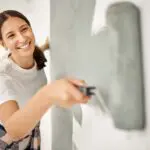
It’s no secret that a fresh coat of paint can breathe new life into any room. However, have you recently thought about upgrading the outside of your home or business? A fresh coat of paint on the exterior of your building is a great way to improve its appearance and protect it from the elements.
Check out our top tips and tricks for painting the exterior of your home or business below.
Take the Proper Safety Precautions
Painting isn’t exactly the most dangerous of DIY projects, but there are still some safety precautions you should take to avoid unnecessary risks and accidental injury. Before starting any exterior painting project, make sure you:
- Read the label on your paint cans and follow all the manufacturer’s instructions.
- Wear proper clothing, including long pants, a long-sleeved shirt, and closed-toe shoes to avoid getting paint on your skin.
- Wear a dust mask to avoid inhaling any fumes from the paint.
- Use a ladder or step stool to reach high areas, and always have someone nearby to spot you.
Gather the Correct Supplies
In order to get started, you’ll need to gather all the necessary supplies for your exterior painting project. This includes:
- Paint – You’ll need enough paint to cover the entire exterior of your home or business. When choosing a paint, it’s best to choose a high-quality exterior paint that is specifically designed for the material of your building. For example, if you’re painting a brick home, you may want to use a different type of paint than if you were painting a wooden shed.
- Paint Brushes – A variety of paint brushes will come in handy, including a 2-3 inch brush for trim work and a 4-6 inch brush for painting large areas.
- Paint Rollers – Paint rollers are great for painting large, flat surfaces quickly. Be sure to get a paint roller with an extension handle so you can reach high areas without using a ladder.
- Ladder or Step Stool – As we mentioned earlier, you’ll need a ladder or step stool to reach high areas when painting the exterior of your home or business.
- Drop Cloths – Drop cloths are essential for protecting any surfaces that you don’t want to get paint on, including driveways, walkways, and landscaping.
- Tarp – A tarp can be helpful for covering larger areas when you’re painting, such as a patio or deck.
Prepare the Surface
Before you start painting, it’s important to prepare the surface of your home or business. This includes:
- Cleaning – Start by giving the entire exterior a good cleaning with a pressure washer or hose. This will remove any dirt, dust, or debris that could prevent the paint from adhering properly.
- Repairing – Next, you’ll want to make any necessary repairs, such as filling in cracks, holes, or gaps in the surface. This will help create a smooth surface for painting.
- Sanding – Once the surface is clean and repaired, you’ll want to sand it down to create an even surface. Be sure to use fine-grit sandpaper so you don’t damage the surface.
- Priming – Finally, you’ll want to apply a primer to the surface. This will help the paint adhere better and give you a more even finish.
Plan an Efficient Strategy
Once you have all your supplies and the surface is prepared, it’s time to start painting. But before you start randomly painting away, it’s important to plan an efficient strategy. Determine which areas you will paint with the roller versus the paint brush. For example, you may want to use the roller for painting large flat surfaces and the brush for painting around windows, doors, and other trim areas.
Keep in mind the time of day you should be painting. The best time to paint the exterior of your home or business is in the morning or evening when it’s not too hot outside. This will help prevent the paint from drying too quickly and creating a streaky finish.
Review Different Techniques
There are a variety of different painting techniques that you may want to use for your exterior painting project. Some common techniques include painting from the top to bottom to help control streaks. Another technique is to roll the paint in small sections and then brush it out while it’s still wet to avoid lap marks.
You may also want to try using a paint sprayer for large exterior painting projects. This can help you cover a larger area more quickly and evenly. Just be sure to practice with the sprayer before using it on your project to avoid any accidents.
Let Harpeth Painting Take Care of Your Painting Project
Exterior painting can be a daunting task, but with the right preparation and tools, it can be a DIY project that you can complete in no time. We’ve provided some essential tips and tricks to help you get started, but if you’re still unsure of where to start or need help with the actual painting process, our team of experts are here to help.
Contact us today to learn more about our Nashville exterior painting services and request a quote.


